

What is a Provisional Patent and its Advantages. A provisional patent application is a preparatory stride, before documenting of a regular patent, for getting a sort of between interim protection.
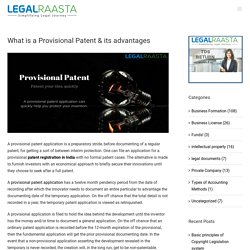
One can file an application for a provisional patent registration in India with no formal patent cases. The alternative is made to furnish investors with an economical approach to briefly secure their innovations until they choose to seek after a full patent. A provisional patent application has a twelve month pendency period from the date of recording after which the innovator needs to document an entire particular to advantage the documenting date of the temporary application. On the off chance that the total detail is not recorded in a year, the temporary patent application is viewed as relinquished. A provisional application is filed to hold the idea behind the development until the inventor has the money and/or time to document a general application. The preliminary process is faster and the cost is low– Extending the patent term –
What is TDS (tax deducted at source) and how it is estimated? What is difference between trademarks and other intellectual property? What are the Documents Required for Home Loan? Ways to get mortgage loan approved. 20 quick FAQ’S on credit score in India. 5 tips to create strongest patent possible. Assessment of non-filers and unregistered person under GST. Eligibility, utilisation, reversal, etc of Input tax credit. Different types of supply under GST regime. Whos is exempt from registration under GST?
Dispute resolution mechanism under GST. Dispute resolution mechanism under GST For smooth implementation of GST in our country it is important to have an inbuilt parallel dispute resolution mechanism assuming various issues in GST regime.

In international arena two approaches are followed: There must be resolution mechanismThere should be a prevention system. It is necessary to save time, money, hassle and closure of trade. Determination place of supply of goods. To easily determine the place of supply of goods and services, rules are made in the law.
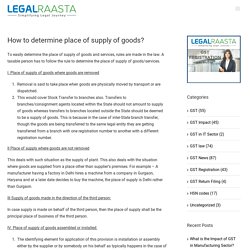
A taxable person has to follow the rule to determine the place of supply of goods/services. I. What is destination based consumption tax? Indirect taxes can be either origin based or destination based.
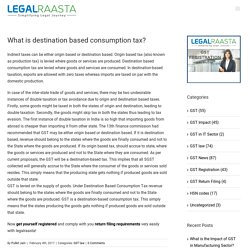
Origin based tax (also known as production tax) is levied where goods or services are produced. Destination based consumption tax are levied where goods and services are consumed. In destination-based taxation, exports are allowed with zero taxes whereas imports are taxed on par with the domestic production. What is debit/credit note and it's treatment under GST? A debit/credit note serves the purpose of accounting adjustment to settle the correct amount of value and tax as the case may arise from time to time.
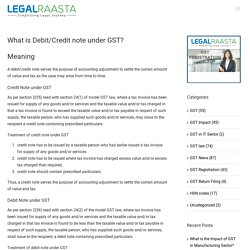
Credit Note under GST As per section 2(35) read with section 24(1) of model GST law, where a tax invoice has been issued for supply of any goods and/or services and the taxable value and/or tax charged in that a tax invoice is found to exceed the taxable value and/or tax payable in respect of such supply, the taxable person, who has supplied such goods and/or services, may issue to the recipient a credit note containing prescribed particulars. Tax refund provisions under GST mode law. Tax Refund under GST Tax refund includes refund of tax on goods and/or services exported out of India or on inputs or input services used in the goods and/or services which are exported outside India, or refund of tax on the supply of goods regarded as deemed exports, or refund of unutilized input tax credit as provided under section 38(2).

The application for the refund of tax/interest can be made within 2 years.A registered person can claim refund of any unutilized ITC at the end of any tax period.The application for claiming the refund can be made at the end of the each quarter.Thr refund cannot be provided if the amount of the refund so claimed is less than 1,000 rupees. Exceptions The refund of which is claimed by the taxpayer shall be granted within 60 days from the date of receipt of complete application. If a refund is not sanctioned within the stipulated period of 60 days, Interest is payable not exceeding the rate @ 6%. All about GST annual Return(GSTR-9) Return filing for non-resident foreign taxpayers. Non-Resident foreign taxpayers are those suppliers who have come for a short period to make supplies in India without having any business establishments here.
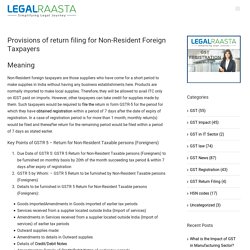
Products are normally imported to make local supplies. Therefore, they will be allowed to avail ITC only on IGST paid on imports. However, other taxpayers can take credit for supplies made by them. Such taxpayers would be required to file the return in form GSTR-5 for the period for which they have obtained registration within a period of 7 days after the date of expiry of registration. In a case of registration period is for more than 1 month, monthly return(s) would be filed and thereafter return for the remaining period would be filed within a period of 7 days as stated earlier. Key Points of GSTR 5 – Return for Non-Resident Taxable persons (Foreigners) What is the treatment of Job Work under GST? Job work (inputs/Semi-finished/Finished goods) means undertaking any treatment or process by a person of goods belonging to another registered taxable person and the expression “job worker” shall be construed accordingly.

If the person is unregistered, then the job work relation could not be established under GST law. Basis for Job work A manufacturer may send out his goods to a job work for an intial process, intermediate process, assembly, packaging or any other completion process & later supply such goods to its customers or use in any other manufacturing process accompanied by its own.The goods sent for job work may be raw material, components parts, semi finished goods & even finished goods. What is the concept of supply under GST. The basis of a charge of GST is the supply.
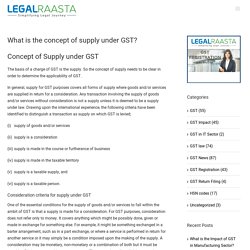
So the concept of supply needs to be clear in order to determine the applicability of GST. In general, supply for GST purposes covers all forms of supply where goods and/or services are supplied in return for a consideration. Any transaction involving the supply of goods and/or services without consideration is not a supply unless it is deemed to be a supply under law. Drawing upon the international experience, the following criteria have been identified to distinguish a transaction as supply on which GST is levied; What are the kinds of assessment under GST. Assessment of taxes to be paid is required to be done to establish the tax liability of an assessee.
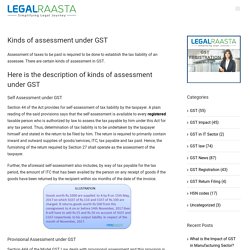
There are certain kinds of assessment in GST. Self Assessment under GST Section 44 of the Act provides for self-assessment of tax liability by the taxpayer. Reverse charge mechanism under GST. Reverse Charge means the liability to pay the tax by person receiving goods and/or services instead of the person supplying the goods and/or services in respect of specified categories of supplies. In India, the concept of reverse charge under GST is being introduced which is already present in service tax. Reverse charge under GST may be applicable for both services as well as goods. Dispute resolution mechanism under GST. How to use input tax credit under GST? Input tax credit is one of the essential elements of Value added tax system which is used as a tool to avoid cascading effect of tax.
A supplier is allowed to set off the tax he has paid on the purchase of goods from output tax on the sale of such goods. This is results in a levy of tax only on the value added by the intermediate supplier and hence avoiding double taxation. Under GST regime, the tax has been divided into three main parts namely ‘Integrated Goods and Services Tax’(IGST), ‘Central Goods and Services Tax’(CGST) and ‘State Goods and Services Tax’(SGST). This bifurcation of taxes might lead to confusion as to how the input and output taxes are to be adjusted. What is the appeal filing mechanism under GST? Any appeal under GST is an application to a higher court for a reversal of the decision of a lower court. Appeals arise when there are any legal disputes.A strong appeal under GST mechanism is in case when, A person is hurt by any decision or order passed against him.
Any person hurt by any decision; orAn order is passed against him under this Act by an adjudicating authority may appeal to the prescribed First Appellate Authority. What is the procedure and criteria for TDS under GST? The provisions of TDS are introduced in the law in order to regulate unorganized sectors in the market. We are providing all the information related to the procedure and criteria for TDS under GST. (a) Department or establishment of the Central or State Government, or (b) Local authority, or (c) Governmental agencies, or. Different types of supply under GST regime.
Varoius offences listed under GST. The Model GST Law codifies the offenses and penalties in Chapter XVI. The Act lists twenty-one offenses in section 66, apart from the penalty prescribed under section 8 for availing compounding by a taxable person who is not eligible for it. We are providing the various offenses listed under GST. What is the impact of GST on Indian Economy? India’s historic approval of the Goods and Services Tax (GST) marked a benchmark development of the economy of the country but GST may disrupt the economy for a short-term. Till now, an introduction of VAT (Value Added Tax) at the state level and CENVAT at central level are considered to be largest indirect tax reforms in the country and GST is the next logical step towards making India a good market.
GST Payment Process. GST refers to the Goods and Sales Tax bill, which is officially known as The Constitution bill, 2014 (one hundred and twenty-second amendment) to be implemented from 1 April 2017. GST has three categories in the bill that are CGST (central good and services tax), SGST (state goods and services tax) and IGST (integrated goods and services tax). Revenue collected from CGST is collected by the central government and SGST’s revenue is collected by the state government, whereas IGST’s revenue is collected and distributed among the state government and central government.
Constitutional amendments for GST implication. Creation of Challan while making payment under GST. Import and Export under the Proposed GST - LegalRaasta. Composition scheme under GST and it's eligibility, benefits. Goods and Services Tax (GST) is set to bring a new regime of business compliance in India. Now-a-days, large organizations have resources as well as the expertise in order to address these requirements. On the other side, many Start-ups and Small and Medium Enterprises (SMEs) struggles in order to complete these provisions.
Steps for GST return. The Goods and Services tax (GST) , has been one of the most major reform in India’s indirect tax structure since the economy began to be opened 25 years ago . The Constitution (122nd ) Amendment Bill will be implemented from April 1 , 2017 . Time of supply of advance receipts under GST. Return filing through tax return preparers. Search under GST, authorization, safeguards offered etc. The term search under GST, in simple language, denotes an action of a government machinery to go, look through or examine carefully a place, area, person, object etc. in order to find something concealed or for the purpose of discovering evidence of a crime. The search of a person or vehicle or premises etc. can only be done under the proper and valid authority of law. Composition scheme under GST and it's eligibility, benefits. What is the concept of supply under GST.
GST Electronic ledger : Cash ledger, ITC ledger & Tax liability ledger. Time of supply in case of change in effective tax rate. What is Patent License and what are its functions? Here’s all you need to know about filing extended last date to file ITR. Filing Income Tax Return to become simple from April 1. How mortgage helps to better your CIBIL Score. Know all about refinance home loan. Know all about Loan Against Property. 10 things you need to know about tax saving fixed deposits. 10 things individual tax payers should know Tax saving fixed deposits. Budget 2017 does little to expand taxpayer salaried still bear brunt of taxes. How to file a paper income tax return? All about bad credit loans. Looking for personal loan in delhi? Take care of these things when taking small business loans. When to refinance - LoanRaahi. What is Balance transfer and Top-up of loan?
LegalRaasta - Legalraasta. Loanraahi. LegalRaasta's soup. Home - Loanraahi's website. Home - Legalraasta's website. Home. Classification of Goods and Services under Trademark Registration. All you need to know about Trademark Search. All about return filing under GST regime. Steps to register your Trademark in Kolkata. Steps to register your Trademark in Delhi. Steps to register your Trademark in Chennai. Which return should I file ITR-1, ITR-2, ITR-3 or ITR-4? 7 Things You Need to Know Before Filing Your Income Tax Return. Which ITR shall I file for rental Income? How can we assess income of Non Returning Indian? What is Best Judgement Assessment ? How do I pay GST tax online? Basic terms under Good and Service Tax. Advantages and Disadvantages of Letter of Credit. How to overcome negative thoughts in Export Business?
How can Foreigners file Return on Income earned in India? File income tax return online. Why intellectual property is so critical for startups? Get a patent software, but be prepared for a frustrating process. What is digital deposit act, and digital sources for obtaining copyright? How can NRI’S file income tax return in India? How to File your ITR through LegalRaasta? 10 things you shouldn't miss out before taking a home loan. Why is it difficult to get a small business loan after bankruptcy?
Why taking a personal loan to pay off other debts is not a bad idea either? Step wise filing ITR and all the links which you need to know. 5 things you need to know to make use of the ITR deadline extension. How to calculate capital gain tax and what are it's exemptions ? Who is eligible to file the ITR-1 Form? Understanding income tax implications for Professionals & Freelancers. What is the impact of GST in manufacturing sector? How to file multiple-class trademark application? What is trademark and how to do registration of your trademark in India?
What is Trademark statement of use & Requirements for filing it? Have a brilliant idea, How to keep it safe with trademark, patent & copyright. GST as a destination based tax as against the concept of origin based tax.